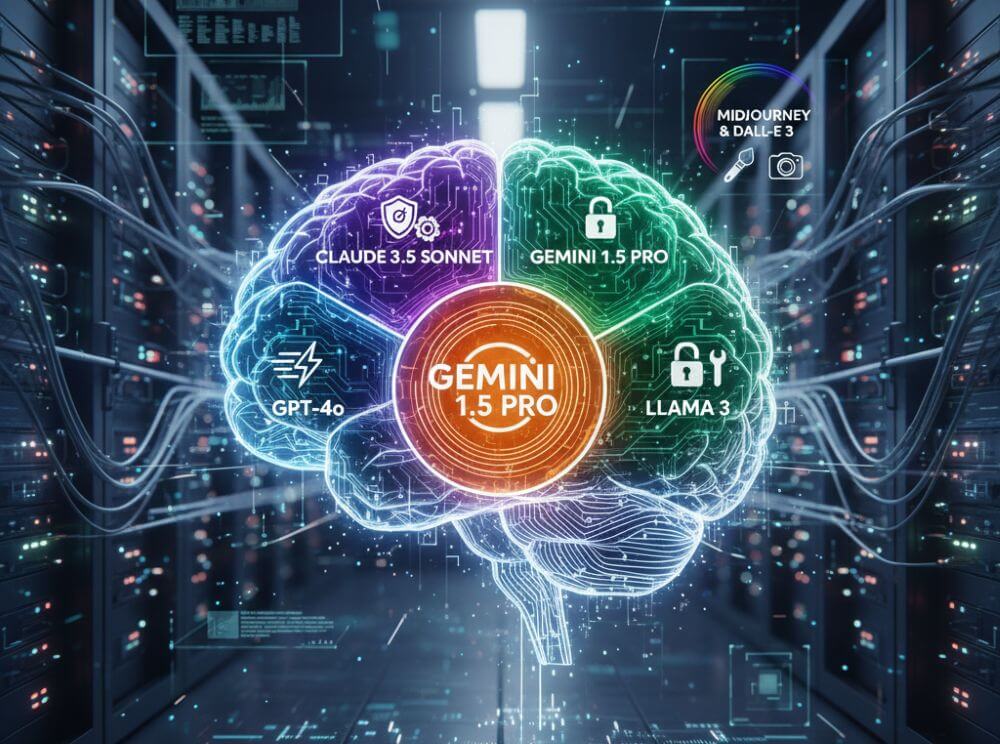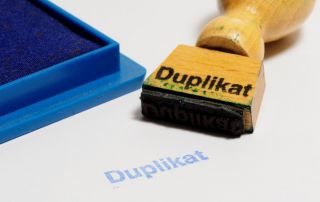The great AI showdown: Which model is right for you?
The artificial intelligence market is a jungle. New models and updates appear almost weekly, promising to eclipse everything that has come before. GPT, Claude, Gemini, Llama – who can keep track of it all?
Don’t worry. This article will shed some light on the subject. We’ll examine the most important AI models currently dominating the market, analyze their strengths and weaknesses, and answer the most crucial question: Which model best suits your needs?

The Titans: Closed Source Models
These are the heavyweights developed by large tech companies. They generally offer the highest performance and ease of use, but come with limitations in customization and cost.
1. OpenAI: The GPT Series (GPT-4o, GPT-4 Turbo)
OpenAI, backed by Microsoft, is the market leader. With ChatGPT, they made AI hype accessible to the masses.
The model: GPT-4o (“o” for Omni) is the current flagship. It’s a native multimodal model that can fluently process text, audio, and images in real time.
Advantages (Pros):
- Extremely powerful all-rounder: Very good at logical thinking, creative writing, and conversation.
- Speed: GPT-40 is significantly faster than its predecessor, GPT-4.
- Multimodality: The seamless integration of speech (natural-sounding conversation) and image recognition is market-leading.
- Ecosystem: Strong integration with many third-party tools and Microsoft products (Azure, Copilot).
Disadvantages (Cons):
- Costs: Using the API (Application Programming Interface) can become expensive with intensive use.
- “Black Box”: As a closed model, you have no control over the internal processes or training data.
Suitable for:
- Everyday users: Those who need a computer for everyday tasks after the Looking for the “best” chatbot (via ChatGPT Plus)?
- Developers: Those who need a robust and versatile API for their applications.
- Content creators: Those seeking inspiration and support for writing or brainstorming.
2. Anthropic: The Claude series (Claude 3.5 Sonnet, Claude 3)
- Founded by former OpenAI researchers, Anthropic places an extremely strong emphasis on security and ethics. They are OpenAI’s strongest competitor.
- The model: Claude 3.5 Sonnet recently made headlines by outperforming GPT-40 in many benchmarks (especially in programming and logical reasoning). The Claude 3 family also includes Opus (the most powerful) and Haiku (the fastest).
Advantages (Pros):
- Excellent logical reasoning: Often perceived as more precise and “intelligent” at complex tasks (law, science, coding).
- Security: Developed according to the “Constitutional AI” principle, resulting in more reliable and ethical answers (fewer “hallucinations” or strange outbursts).
- Long texts: Very strong at analyzing and summarizing long documents.
Cons:
- Multimodality: Image analysis is good, but (still) not as fluid and fast as GPT-40.
- Availability: Somewhat lower adoption and API integration than OpenAI.
Suitable for:
- Companies: Those that value data security and reliable, Ethical answers are needed.
- Programmers & Academics: Those who need a “workhorse” for complex logic problems or text analysis.
3. Google: The Gemini Series (Gemini 1.5 Pro & 1.5 Flash)
Google has consolidated its AI efforts with Gemini. Gemini’s key advantage lies in its enormous “context window.”
The model: Gemini 1.5 Pro is the main model. “Context window” refers to how much information the model can process at once. Gemini 1.5 Pro can process 1 million “tokens” by default—equivalent to an entire book or an hour of video.
Advantages (Pros):
- Huge context window: Unbeatable when analyzing very large documents (e.g., “Find clause X in this 500-page contract”) or entire code databases.
- Video analysis: Can analyze videos and answer questions about them.
- Google integration: Deeply embedded in the Google ecosystem (Google Search, Google Workspace, Android).
Cons:
- Creativity: Sometimes perceived as somewhat “dry” or less creative in its writing style than GPT or Claude.
- Fine-tuning: In some areas (e.g., coding), not quite at the level of Claude 3.5.
Suitable for:
- Data analysts & Researchers: Those who need to analyze huge amounts of data (text, code, video) all at once.
- Users of the Google ecosystem: Those who want to use AI directly in their emails, documents, and search queries.
The challengers: Open-source models
Open-source models can be downloaded, customized, and run on your own hardware (or in your own cloud) free of charge. This provides maximum control and data privacy.
4. Meta: Llama 3
Meta (Facebook) is a major driving force behind the open-source movement.
The Llama 3 model (available in sizes such as 8B, 70B, and soon 400B parameters) is currently the most powerful freely available model.
Advantages:
- Data Privacy & Control: Since it’s self-hosted, no data leaves your company.
- Adjustability (Fine-Tuning): Can be perfectly trained for very specific tasks (e.g., a chatbot with only medical expertise).
- Free: No license or API costs (apart from hardware costs).
Cons:
- Technical Effort: Requires powerful hardware (expensive GPUs) and technical expertise for operation and training.
- Security “Out of the Box”: The basic models are often less “censored” or secured than commercial products.
Suitable for:
- Startups & Enterprises: Use AI as the core of their application and require full control.
- Researchers & Hobbyists: Those who want to experiment with AI and build their own versions.
- Companies with strict data protection regulations: (e.g., banks, healthcare).
5. Mistral AI
The Paris-based startup Mistral has established itself as Europe’s AI champion.
The model: Mistral Large (commercial) and the Mixtral series (open source). Mixtral uses a “Mixture of Experts” (MoE) architecture.
Advantages (Pros):
- Efficiency: The MoE models are extremely fast and resource-efficient relative to their performance.
- Strong performance: Mistral models often outperform similarly sized Llama models.
- European focus: An advantage for companies that value EU compliance and data sovereignty.
Disadvantages (Cons):
- Smaller ecosystem: (Not yet) as widely supported as Llama or the “Big 3”.
Suitable for:
- European companies: Those seeking a powerful yet efficient alternative.
- Applications where speed (latency) is critical.
Specialists: The image generators
Text isn’t everything. When it comes to image creation, other names dominate:
Midjourney:
The undisputed king for artistic and photorealistic quality. The results are often breathtakingly stylized and “beautiful.” It’s primarily used via Discord.
DALL-E 3 (by OpenAI):
The best when it comes to text recognition. If you type “A red elephant sitting on a yellow bicycle reading a newspaper,” DALL-E 3 will render it most accurately. Perfectly integrated with ChatGPT.
Stable Diffusion (Open Source):
The Swiss Army knife of images. Open source, infinitely customizable (with “ControlNets” and “LoRAs”), but technically the most demanding. Used for very specific styles or tasks (e.g., product mockups).
Conclusion: Which AI model is right for whom?
There isn’t one best model. It depends on the task.
For everyday use & creative writing:
- GPT-4o (via ChatGPT) offers the most comprehensive and creative experience.
For programming & Complex logic:
-
- Claude 3.5 Sonnet often comes out on top here.
For analyzing huge documents or videos:
-
- Gemini 2.5 Pro is unbeatable thanks to its context window.
For companies with data protection needs:
- Llama 3.3 (self-hosted) offers maximum control.
For artistic Images:
Midjourney for the aesthetics, DALL-E 3 for the precise execution of instructions.
Beliebte Beiträge
The heart of AI regulation: What is the EU’s new “AI office”?
The new EU AI Office (European AI Office) is the central authority for enforcing and monitoring the AI Act. It regulates high-risk AI and general-purpose AI models (GPAI), coordinates EU member states, and promotes trustworthy AI innovation in Europe.
More than just a password: Why 2-factor authentication is mandatory today
Why is two-factor authentication (2FA) mandatory today? Because passwords are constantly being stolen through data leaks and phishing. 2FA is the second, crucial barrier (e.g., via an app) that stops attackers – even if they know your password. Protect yourself now!
Beware of phishing: Your PayPal account has been restricted.
Beware of the email "Your PayPal account has been restricted." Criminals are using this phishing scam to steal your login information and money. They pressure you into clicking on fake links. We'll show you how to recognize the scam immediately and what to do.
Excel Tutorial: How to quickly and safely remove duplicates
Duplicate entries in your Excel lists? This distorts your data. Our tutorial shows you, using a practical example, how to clean up your data in seconds with the "Remove Duplicates" function – whether you want to delete identical rows or just values in a column.
Who owns the future? AI training and the global battle for copyright.
AI companies are training their models with billions of copyrighted works from the internet – often without permission. Is this transformative "fair use" or theft? Authors and artists are complaining because AI is now directly competing with them and copying their styles.
Dynamic ranges in Excel: OFFSET function
The OFFSET function in Excel creates a flexible reference. Instead of fixing =SUM(B5:B7), the function finds the range itself, e.g., for the "last 3 months". Ideal for dynamic charts or dashboards that grow automatically.

































